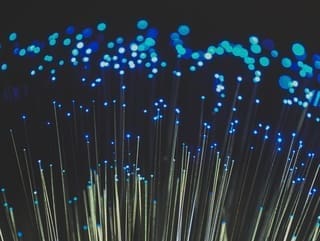Discovering How Fiber Internet Works
Feb 13, 2023 | General
Since its advent in 1970, fiber-optic technology has revolutionized data transmission, emerging as the most sophisticated and efficient method for online communication. Today, fiber optics form the backbone of global internet infrastructure, propelling data across vast distances at speeds nearing that of light. At Hunter Communications, we’re constantly working to expand fiber-optic internet to communities in Oregon and Northern California. Here’s a little information to answer your questions about how fiber internet works to help you understand the options you have for internet connectivity for your home and business.
What is a fiber-optic cable?
Fiber internet uses a network of fiber-optic cables to transmit data. Fiber-optic cables consist of incredibly fine strands of glass or plastic known as optical fibers, capable of transmitting light signals over long distances. These fibers are surprisingly durable; on a per-inch basis, they are stronger than steel and more robust than copper. They are also resistant to degradation and interference common to copper wires.
How are fiber-optic cables made?
The production of fiber-optic cables is a precise and intricate process:
1. Creation of Preform Glass: The process begins with the formation of thick glass cylinders using a ceramic rod to collect silicon dioxide, which is then purified.
2. Dehydration: These glass cylinders are meticulously dehydrated in a specialized furnace to remove moisture and prevent impurities.
3. Drawing Fibers: The dehydrated glass is then heated and drawn out into exceedingly thin strands.
4. Coating: Finally, these strands are coated with a protective layer of rubber to enhance durability and prevent damage.
How do fiber-optic cables work?
A fiber cable comprises three essential components:
1. Core: The core contains ultra-thin glass fibers with a high refractive index, allowing light to transmit data efficiently.
2. Cladding: The cladding, which surrounds the core, is also made of glass but is designed to keep the light signals contained by reflecting them along the path.
3. Coating: A rubber outer coating protects the fibers from environmental and mechanical damage.
Despite some resistance in the glass reducing the speed, fiber-optic signals can travel at about 70% of the speed of light, making it the fastest medium for data, voice, and video transmission.
Advantages of Fiber for Last-Mile Connectivity
Have you ever wondered how the internet pipeline works? In short, internet communication to the World Wide Web is connected to communities at centralized hubs before being distributed to homes and businesses.
In telecommunications terminology, this centralized hub is called a central office (CO) or, in the context of fiber-optic networks, a Point of Presence (PoP). These hubs house the necessary telecommunications equipment and switch gear to manage and route internet traffic to and from various endpoints in the service area. Fiber-optic cables are the predominant method for getting data to a community’s PoP.
“Last mile” refers to the distance from the PoP to the home or business. While fiber-optic cables are predominant in core network infrastructures up to the PoP, many last-mile connections still utilize copper. However, fiber offers several significant advantages over copper for these final segments of network architecture:
1. Speed: Fiber provides unparalleled speeds for both uploading and downloading data.
2. Reliability: Unlike copper, fiber does not carry electric current, making it immune to electromagnetic interference and less affected by temperature changes.
3. Cost-Effectiveness: Fiber cables are more durable and resistant to corrosion, which translates to lower maintenance costs and longer service life.
4. Efficiency: Fiber cables can be densely packed in small diameters, allowing more data to pass through less space without risk of interference.
5. Safety: Because fiber cables do not have electrical transmission, they pose a lower fire risk than copper cables, which can overheat.
Now that you know how fiber internet works, why would you choose anything else?
As the demand for higher bandwidth and faster internet continues to grow, the public and private sectors are increasingly investing in replacing outdated copper networks with robust fiber-optic connections. Fiber’s superior design ensures it can meet future demands for increased internet usage and connectivity speeds. Understanding how fiber internet works allows you to make better decisions about choosing the best internet service for your home or business.
At Hunter Communications, we are dedicated to providing state-of-the-art fiber-optic internet services to our customers in Oregon and Northern California. Our commitment to excellence is reflected in our award-winning network, designed to deliver the ultimate internet experience. Join us in embracing the future of internet connectivity—sign up today.
Want to join Hunter’s Fiberhood? Let’s see if we’re already in your area! If not, entering your address will help us determine where to expand next.

